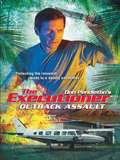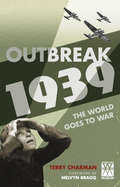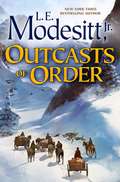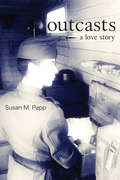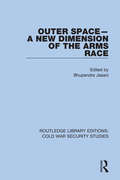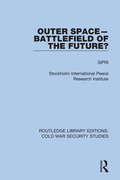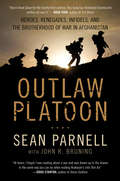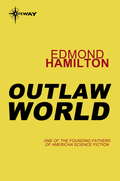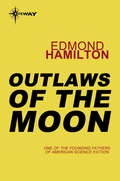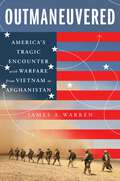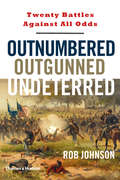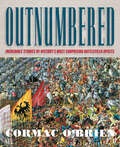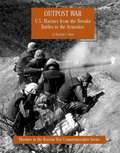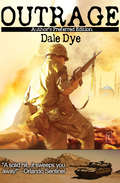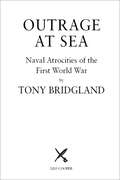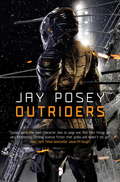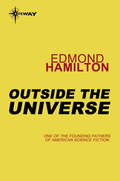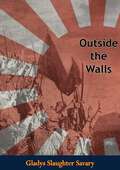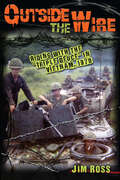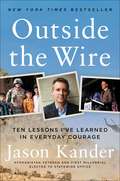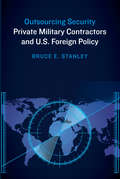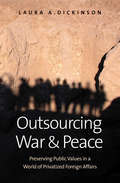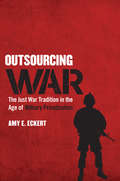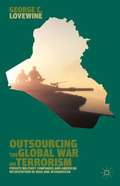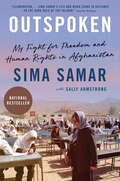- Table View
- List View
Outback Assault
by Don PendletonWhen a paid assassin starts killing innocent people, it's time to take him out. But while eliminating one killer, Mack Bolan stumbles onto a deadly drug pipeline that takes him deep into the Australian Outback--and into the heart of the Asian mob. To destroy the enemy Bolan must protect the one thing standing in the Triad's way--a young Aboriginal girl. With the Triad and a highly trained covert team--funded by the dead assassin's partner--tracking him, the Executioner is caught in a lethal cross fire. To survive, he'll have to use skills he never knew he had.
Outbreak: The World Goes to War
by Terry Charman11:15 am, 3 September 1939. The nation gathers around their radios to hear Prime Minister Neville Chamberlain make the announcement they have feared for months: Britain is at war with Germany. Seventy years on from that historic day, this is the definitive history of the build-up to, outbreak and first few months of World War Two, from the events of early 1939, right through to the first war-time Christmas. Drawing on the Imperial War Museum's extensive archives, this book will feature the personal stories of real men and women who lived through the startling events of that year, as well as those who were actively involved in the political negotiations and their aftermath.Featuring numerous photographs and the voices of key players, as well as contributions from well-known figures who were directly affected by the build up to an outbreak of war, this will be a unique document of an extraordinary year in our history.
Outcasts of Order (Saga of Recluce #20)
by L. E. Modesitt Jr.Beltur, an Order mage, discovers he possesses frightening powers not seen for hundreds of years. With his new abilities, he survives the war in Elparta and saves the lives of all. However, victory comes with a price. His fellow mages now see him as a threat to be destroyed, and the local merchants want to exploit his power. There’s only one way he can remain free and survive—he’s going to have to run.
Outcasts: A Love Story
by Susan M. PappIn this story of love and loss, Tibor Schroeder, a Christian and reservist in the Hungarian forces allied with Nazi Germany, and Hedy Weisz, a young Jewish woman meet and fall in love during the Second World War - a time when romantic liaisons and marriage between Christians and Jews were not only frowned upon but against the law. Not knowing of the dangers that await them, Tibor and Hedy pledge their lives to each only to be torn apart when Hedy and her family are herded into one Nagyszollos’ ghettoes. Twenty-five years pass before the lovers are finally reunited in Canada. Based on true events, this sprawling love story of hope, courage, and redemption will stay with readers long after finishing the book. A documentary, based on this story, from Postmodern Productions is scheduled for release in March 2009.
Outer Space - A New Dimension of the Arms Race: A New Dimension Of The Arms Race (Routledge Library Editions: Cold War Security Studies #35)
by Bhupendra JasaniThis book, first published in 1982, analyses the prospects of the Cold War superpowers arms race spilling into outer space. A SIPRI-organized symposium in 1981 discussed the consequences of the militarization of outer space, as well as further arms control and disarmament measures. This book presents the findings of 20 eminent scientists, lawyers and diplomats from 12 different countries.
Outer Space - Battlefield of the Future?: Battlefield Of The Future? (Routledge Library Editions: Cold War Security Studies #34)
by SipriThis book, first published in 1978, examines the military use of space – around 60 per cent of US and Soviet satellites were military ones. The satellites were for military communications, weather prediction, navigation, photographic and electronic reconnaissance, targeting, early warning, and satellites capable of destroying enemy satellites. This book analyses the capabilities of military satellites as part of the debate around the encroachment of military technology and purposes into space.
Outlaw Platoon: Heroes, Renegades, Infidels, and the Brotherhood of War in Afghanistan
by John Bruning Sean ParnellIn combat, men measure up. Or don't. There are no second chances. In this vivid account of the U.S. Army's legendary 10th Mountain Division's heroic stand in the mountains of Afghanistan, Captain Sean Parnell shares an action-packed and highly emotional true story of triumph, tragedy, and the extraordinary bonds forged in battle. At twenty-four years of age, U.S. Army Ranger Sean Parnell was named commander of a forty-man elite infantry platoon-a unit that came to be known as the Outlaws-and was tasked with rooting out Pakistan-based insurgents from a mountain valley along Afghanistan's eastern frontier. Parnell and his men assumed they would be facing a ragtag bunch of civilians, but in May 2006 what started out as a routine patrol through the lower mountains of the Hindu Kush became a brutal ambush. Barely surviving the attack, Parnell's men now realized that they faced the most professional and seasoned force of light infantry the U.S. Army had encountered since the end of World War II. What followed was sixteen months of close combat, over the course of which the platoon became Parnell's family: from Staff Sergeant Greg Greeson, the wise, chain-smoking veteran who never lost his cool; to Specialist Robert Pinholt, a buttoned-down conservative with the heart of a warrior and the mind of an economist; to Staff Sergeant Phil Baldwin, the platoon's voice of calm and reason, a man who sacrificed everything following the events of 9/11-career, home, financial stability-to serve his country. But the cost of battle was high for these men: Over 80 percent were wounded in action, putting their casualty rate among the highest since Gettysburg, and not all of them made it home. A searing and unforgettable story of friendship in battle, Outlaw Platoon brings to life the intensity and raw emotion of those sixteen months, showing how the fight reshaped the lives of Parnell and his men and how the love and faith they found in one another ultimately kept them alive.
Outlaw World
by Edmond HamiltonDREAD PERIL FROM BEYOND DEEP SPACEWhere are they from and what is their ultimate evil purpose?A band of dread invaders, led by a ruthless genius, is overcoming the system, sapping it of radium - its most vital element - killing all who stand in the way. Captain Future must find their base - their Outlaw World - and crush their deadly plot. He is the last hope in a crumbling solar system.
Outlaws of the Moon
by Edmond HamiltonThe sorrowful cry spread throughout the Solar System. Captain Future and his Futuremen had been missed for months. There was little hope that they'd ever be seen again...A scheming scientist headed for the moon. Now was his chance to find the Futuremen's hideaway and steal their highly guarded secrets, secrets that could control the Universe. No one could stop him - not even the sinister lunar creatures - now that Captain Future was dead!
Outmaneuvered: America's Tragic Encounter with Warfare from Vietnam to Afghanistan
by James A. WarrenFrom a celebrated military historian, a highly engaging and thought-provoking exploration of why the United States has failed again and again in irregular wars and military campaigns from Vietnam to Afghanistan.Since the early 1960s, the United States has fought in four major wars and a cluster of complicated and bloody irregular warfare campaigns. The majority have ended in failure, or something close to it. Why has the US been so ineffective, despite the American armed forces being universally recognized as the best in the world?Most scholars and analysts believe that the primary cause of our abysmal war record since Vietnam has been the US military&’s overwhelmingly conventional approach to conflict, which favors kinetic operations, highly mobile precision firepower, and sophisticated systems of command and control. Here, James Warren argues that a much more formidable obstacle to success has been pervasive strategic ineptitude at the highest levels of decision-making, including the presidency, the national security council, and the foreign policy community in DC. Time and time again, American presidents have committed military forces to operations in foreign countries whose politics and cultures they did not fully understand. Presidents of both political parties, including Johnson, Reagan, Bush, Clinton, and Obama have overestimated the capacity of US forces to alter the social and political landscape of foreign nations, and underestimated the ability of insurgents and terrorists to develop effective protracted war strategies that, in time, sap Washington&’s will to carry on the fight.In the War on Terror, Warren asserts that senior military officers have been complicit in extending bankrupt strategies by refusing to speak truthfully about them to their civilian bosses. So have the American people, who lost interest in the conflicts in Afghanistan and Iraq, and refused to press their president and congress to bring an end to two futile conflicts. Warren advocates for a less hubristic foreign policy and a broader conception of warfare as a political and military enterprise.For readers of political, military, and US history—as well as anyone interested in international relations and geopolitical strategy—this book offers unparalleled insights into America&’s prior—and potentially future—military conflicts.
Outnumbered, Outgunned, Undeterred: Twenty Battles Against All Odds
by Rob JohnsonHow military forces have prevailed against the odds, explained through vivid narratives and specially commissioned battle plans. Throughout history men and women have fought, endured, and sometimes emerged victorious though the odds were against them. What conditions must exist to enable relatively small or weak forces to challenge and even overcome the strong? Here are twenty historical examples, from 1777 to the present, that reveal both the common themes and the exceptional aspects of those achievements. The examples range from George Washington's rebuilding of the patriot army in the Revolutionary War to the defense of the Philippines in 1941-42, from Si´mon Boli´var's liberation of South America to Finland's defiance of the Soviet Union in the Winter War of 1939. The courage of the Devonshire Regiment at Bois des Buttes in France in 1918 shows what skillful and determined resistance can achieve, though--as in the defense of Stalingrad in 1943--isolated forces were often left with no option but to fight. The resolve that accompanies a last-ditch effort is demonstrated in the Israeli Defense of the Golan Heights in 1973. Two more recent examples-- the Battle of Debecka Pass in Iraq in 2003 and the battle of the Patrol Bases in Afghanistan, 2006-08--show that some themes from these extraordi-nary historic achievements are still played out in warfare today.
Outnumbered: Incredible Stories of History's Most Surprising Battlefield Upsets
by Cormac O'BrienFourteen dramatic stories of troops outnumbered but not outmatched—from Hannibal’s Carthaginians to the English at Agincourt to the Red Army in WWII.Even a commander as fearless, self-assured, and battle-hardened as Alexander the Great, leading 40,000 Macedonian troops, must have quailed at the sight that met him as he neared the village of Issus, Asia Minor, in 333 BCE: an unexpectedly and unimaginably vast Persian force of some 100,000 men, spanning the Mediterranean coastal plain as far as the eye could see. For warfare had already demonstrated, and has confirmed ever since, that numerical superiority consistently carries the day. And yet, every once in a while, such lopsided engagements have had an unexpected outcome, and proved to be a crucible in which great leaders, and history, are forged.Outnumbered chronicles fourteen momentous occasions on which a smaller, ostensibly weaker force prevailed in an epochal confrontation. Thus, Alexander, undaunted, devised a brilliant and daring plan that disoriented and destroyed the Persian force and, consequently, its empire. Likewise, during the US Civil War, Confederate Gen. Robert E. Lee, despite being out-positioned and outnumbered more than two to one by Union forces at Chancellorsville, Virginia, hatched an audacious and surprise strategy that caught his enemy completely unawares. Other equally unexpected, era-defining victories are shown to have derived from the devastating deployment of unusual weaponry, sheer good fortune, or even the gullibility of an enemy, as when Yamashita Tomoyuki, commander of 35,000 ill-supplied Japanese troops, convinced the 85,000-strong British Commonwealth army to surrender Singapore in 1942.Together these accounts constitute an enthralling survey that captures the excitement and terrors of battle, while highlighting the unpredictable nature of warfare and the courage and ingenuity of inspired, and inspiring, military leaders who, even when the odds seemed insurmountable, found a path to glory.“There are similar titles about decisive battles and interesting campaigns, but none quite like this . . . an appealing choice for many military history enthusiasts.” —Library JournalIncludes color illustrations and maps
Outpost War: U.S. Marines From The Nevada Battles To The Armistice [Illustrated Edition] (Marines In The Korean War Commemorative Series #5)
by Captain Bernard C. NaltyIncludes more than 40 maps, plans and illustrations.This volume in the official History of the Marine Corps chronicles the part that United States Marines played in the hard fighting along the outpost line from 1953 through to the end of the war.The term "Battles of the Outposts" encompasses the fighting that took place in the final two years of the Korean War. In the first year of the war sweeping movement up and down the peninsula characterized the fighting. Combat raged from the 38th Parallel south to the Pusan Perimeter then, with the landing at Inchon and the Perimeter breakout, up to the Yalu, and finally a retreat south again in the face of the massive Chinese intervention.
Outrage (Author's Preferred Edition)
by Dale A. DyeIn 1982 and 1983, American marines were stationed in Beirut with a vaguely defined mission to keep the peace. In 1982, a new Lebanese president, Bachir Gemayel, was elected, but he was assassinated by Moslem terrorists before he could take office. The terrorists relentlessly pressed their guerrilla war, forcing the marines to stay in "the Root" and to participate in an increasingly tense and dangerous mission. Written and now revised by a retired Marine Corps captain who served in Beirut, this brutal, fast-moving novel about the events that led to a massacre of the marines describes Moslem terrorists; Arabs wiling to lay down their lives to stop the fighting; tough Israeli soldiers who deride American peace efforts; wise-guy journalists; and--of course--the marines. Outrage is a fast-paced, authentic, and at times disturbing tribute to those marines who gave their lives in Beirut, even as it angrily condemns the events and policies that led to the deaths of so many brave men.
Outrage at Sea: Naval Atrocities of the First World War
by Tony BridglandThis, the follow-up to Naval Atrocities in World War 2, is an anthology of shameful incidents at sea, causing outrage on both sides. The sinking of the Lusitania was the trigger of these events, which were played out, at least initially, while an anguished and undecided America looked on. Later in the War, the Hospital Ships, carrying wounded troops home from the theatres of war, became controversial targets for U-Boats. The treatment of U-Boat crews by Allied navies was itself at times hugely controversial. At the end of it all, the world's first ever War Crimes Trials were held at Leipzig in farcical conditions.
Outriders
by Jay PoseyThe start of a Military SF series from imprint best-seller and Tom Clancy game series writer Jay Posey.Captain Lincoln Suh died on a Wednesday. And things only got harder from there.Snatched out of special operations and thrown headfirst into a secretive new unit, Lincoln finds himself as the team leader for the 519th Applied Intelligence Group, better known as the Outriders. And his first day on the job brings a mission with the highest possible stakes.A dangerously cunning woman who most assuredly should be dead has seemingly returned. And her plans aren't just devastating, they might be unstoppable.How do you defeat a hidden enemy when you can't let them know they've been discovered?You send in the Outriders.File Under: Science FictionFrom the Paperback edition.
Outside the Universe
by Edmond Hamilton'Spaceships in their thousands, and they're attacking us! They've come from somewhere toward our galaxy - have come out of intergalactic space itself to attack our universe!' The Interstellar Patrol, that fabulous fleet manned by all the assorted races of our galaxy, faced its greatest struggle when that alarm came through. For this was an attack from OUTSIDE THE UNIVERSE, a vast migration from another galaxy, and it had to be stopped if a thousand worlds were to survive! This terrific classic space novel on the grandest scale involves three giant galaxies in an all-out conflict.
Outside the Walls
by Gladys Slaughter SavaryGladys Becker Slaughter, Madame Savary (2 Jun 1893-14 Sep 1985), was an American woman of Manila who labored long and hard to help the starving, neglected, abused, and threatened "internees" at Santo Tomas Internment Camp, supplying them with food every day and performing various other services, such as laundry, communication and monetary assistance, to help ease their hardship. At the same time, she also worked hard to help her servants and friends outside of Santo Tomas survive the Japanese occupation of the Philippines and the 1945 Battle of Manila. Gladys was not incarcerated by the Japanese because, being married to a Frenchman, she was regarded as a citizen of France which by that time had a puppet government aligned with Japan's ally Germany. Gladys also sent help to a POW camp. Several of her activities could have resulted in torture and execution had she been caught. She maintained a diary throughout the Japanese occupation, and made this the basis of her book Outside the Walls.Living in Pasay, Gladys escaped – barely and unknowingly at the time – the massive, systematic massacre of non-Japanese men, women, and children conducted by the Imperial Japanese Navy 31st Special Base Force (marines), as well as deaths caused by U.S. artillery during the Battle of Manila, especially in Ermita and Malate, just next to Pasay. The estimated toll is around 100,000 killed. Even Germans and French were not spared.-Wiki
Outside the Wire: Riding with the "Triple Deuce" in Vietnam, 1970
by Jim RossThis &“wonderfully written&” autobiographical account of a Vietnam vet&’s war experiences &“takes the reader to a strange time and place.&” (Eric M. Bergerud, author of Red Thunder, Tropic Lightning) In the summer of 1969, while America was landing on the moon or rocking out at Woodstock, Jim Ross left his home in Oklahoma to enter the U.S. Army. He arrived in Vietnam in February 1970 to serve his tour, first with the armored personnel carriers of the 2nd Battalion of the 22nd Infantry Regiment (the 2/22 or the &“Triple Deuce&”) of the 25th Infantry. Written from the perspective a kid barely out of high school whose mission was to kill communists and whose goal was to survive, Outside the Wire is a thoughtful, action-packed memoir of one American soldier&’s combat tour in Vietnam. Ross served as a rifleman, machine gunner, tunnel rat, and demolitions man with the 25th infantry and 1st Cavalry divisions. Beginning with a tense ambush patrol, Ross doesn't let up through a year of hair-raising night watches, soggy humps through the jungle, and deadly encounters with the North Vietnamese, including such notable campaigns as the Cambodian incursion.
Outside the Wire: Ten Lessons I've Learned in Everyday Courage
by Jason Kander"In life and in politics, the most important work is often that which happens outside the wire." Going "outside the wire" -- military lingo for leaving the safety of a base -- has taught Jason Kander to take risks and make change rather than settling for the easy option. <P><P>After you've volunteered to put your life on the line with and for your fellow Americans in Afghanistan, cynical politics and empty posturing back home just feel like an insult. Kander understands that showing political courage really just means doing the right thing no matter what. He won a seat in the Missouri Legislature at age twenty-seven and then, at thirty-one, became the first millennial in the country elected to statewide office. <P><P> An unapologetic progressive from the heartland, he rejected conventional political wisdom and stood up to the NRA in 2016 with a now-famous Senate campaign ad in which he argued for gun reform while assembling a rifle blindfolded. That fearless commitment to service has placed him at the forefront of a new generation of American political leaders. In his final interview as President, Barack Obama pointed to Kander as the future of the Democratic Party. "...do something rather than be something..." <P><P>In OUTSIDE THE WIRE, Jason Kander describes his journey from Midwestern suburban kid to soldier to politician and details what he's learned along the way: lessons imparted by his dad on the baseball diamond, wisdom gained outside the wire in Kabul, and cautionary tales witnessed under the Missouri Capitol dome. Kander faced down petty tyrants in Jefferson City -- no big deal after encountering real ones in Afghanistan. He put in 90,000 miles campaigning for statewide office in 2012 -- no sweat compared to the thirty-seven miles between Bagram Air Base and Camp Eggers. When confronted with a choice between what's easy and what's right, he's never hesitated. <P><P> OUTSIDE THE WIRE is a candid, practical guide for anyone thinking about public service and everyone wishing to make a difference. It's a call to action, an entertaining meditation on the demands and rewards of civic engagement, and, ultimately, a hopeful vision for America's future -- all seen through the eyes of one of its most dedicated servants. <P><b>A New York Times Bestseller</b>
Outsourcing Security: Private Military Contractors and U.S. Foreign Policy
by Bruce E StanleyFaced with a decreasing supply of national troops, dwindling defense budgets, and the ever-rising demand for boots on the ground in global conflicts and humanitarian emergencies, decision makers are left with little choice but to legalize and legitimize the use of private military contractors (PMCs). Outsourcing Security examines the impact that bureaucratic controls and the increasing permissiveness of security environments have had on the U.S. military’s growing use of PMCs during the late twentieth and early twenty-first centuries. Bruce E. Stanley examines the relationship between the rise of the private security industry and five potential explanatory variables tied to supply-and-demand theory in six historical cases, including Operation Desert Storm in 1991, the U.S. intervention in Bosnia in 1995, and Operation Iraqi Freedom in 2003. Outsourcing Security is the only work that moves beyond a descriptive account of the rise of PMCs to lay out a precise theory explaining the phenomenon and providing a framework for those considering PMCs in future global interaction.
Outsourcing War and Peace
by Laura A. DickinsonOver the past decade, states and international organizations have shifted a surprising range of foreign policy functions to private contractors. But who is accountable when the employees of foreign private firms do violence or create harm? This timely book describes the services that are now delivered by private contractors and the threat this trend poses to core public values of human rights, democratic accountability, and transparency. The author offers a series of concrete reforms that are necessary to expand traditional legal accountability, construct better mechanisms of public participation, and alter the organizational structure and institutional culture of contractor firms. The result is a pragmatic, nuanced, and comprehensive set of responses to the problem of foreign affairs privatization.
Outsourcing War: The Just War Tradition in the Age of Military Privatization
by Amy E. EckertRecent decades have seen an increasing reliance on private military contractors (PMCs) to provide logistical services, training, maintenance, and combat troops. In Outsourcing War, Amy E. Eckert examines the ethical implications involved in the widespread use of PMCs, and in particular questions whether they can fit within customary ways of understanding the ethical prosecution of warfare. Her concern is with the ius in bello (right conduct in war) strand of just war theory. Just war theorizing is generally built on the assumption that states, and states alone, wield a monopoly on the legitimate use of force. Who holds responsibility for the actions of PMCs? What ethical standards might they be required to observe? How might deviations from such standards be punished? The privatization of warfare poses significant challenges because of its reliance on a statist view of the world. Eckert argues that the tradition of just war theory—which predates the international system of states—can evolve to apply to this changing world order. With an eye toward the practical problems of military command, Eckert delves into particular cases where PMCs have played an active role in armed conflict and derives from those cases the modifications necessary to apply just principles to new agents in the landscape of war.
Outsourcing the Global War on Terrorism
by George C. LovewineOutsourcing the Global War on Terrorism explores how the United States' war on terrorism, in both Iraq and Afghanistan, has required the US military to employ thousands of contracted civilians working for US and foreign Private Military and Private Security Companies (PMSCs). The actions and operations of unsupervised PMSCs has created an environment that had the potential to not only negatively influence tactical US objectives, but could also harm strategic local capacity-building initiatives. Given the military and political importance of US operations in Iraq and Afghanistan, George C. Lovewine provides a much-needed analysis of the interaction between commercial entities, military operations, and policy objectives. Lovewine's analyses identify the reactions and policy responses to these security issues faced by the United States military today.
Outspoken: My Fight for Freedom and Human Rights in Afghanistan
by Sima SamarThe impassioned memoir of Afghanistan's Sima Samar: medical doctor, public official, founder of schools and hospitals, thorn in the side of the Taliban, nominee for the Nobel Peace Prize, and lifelong advocate for girls and women.&“I have three strikes against me. I&’m a woman, I speak out for women, and I&’m Hazara, the most persecuted ethnic group in Afghanistan.&”Dr. Sima Samar has been fighting for equality and justice for most of her life. Born into a polygamous family, she learned early that girls had inferior status, and she had to agree to an arranged marriage if she wanted to go to university. By the time she was in medical school, she had a son, Ali, and had become a revolutionary. After her husband was disappeared by the pro-Russian regime, she escaped. With her son and medical degree, she took off into the rural areas—by horseback, by donkey, even on foot—to treat people who had never had medical help before.Sima Samar's wide-ranging experiences both in her home country and on the world stage have given her inside access to the dishonesty, the collusion, the corruption, the self-serving leaders, and the hijacking of religion. And as a former Vice President, she knows all the players in this chess game called Afghanistan. With stories that are at times poignant, at times terrifying, inspiring as well as disheartening, Sima provides an unparalleled view of Afghanistan&’s past and its present. Despite being in grave personal danger for many years, she has worked tirelessly for the dream she is convinced is an achievable one: justice and full human rights for all the citizens of her country.
